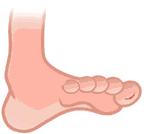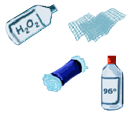A wound is the result of an aggression to the skin and adjacent and subcutaneous tissues. They may be minor or major, depending on how they occurred.
You’re on your bike… cycling fast down your favourite slope and your friend Mec is in front of you, you want to catch up with him and you make a wrong movement, there is some gravel and you don’t want to brake… You have to brake, you don’t… You lose control of the handlebar, you can’t feel the pedals, everything starts to tremble, you’re falling, you’re falling, and you hit the ground!!!… Now you’re lying on the ground.
You’re lying on the ground, and blood starts to ooze from your elbow, there’s some blood coming from you left hand, from your knee.
Types
In general, to make things simpler, we must make a distinction between clean wounds, which are wounds in which we can clearly see that there are no foreign objects or traces of harmful material, and dirty wounds, which include all other types of wounds, wider, deeper or longer wounds in which we are unable to see whether there are any traces of stone inside the wound or where the wound ends, and sometimes it is possible to see an area of damaged flesh.
- Incisive wounds: clean edges.
- Penetrating wounds: with clean, deep edges.
- Contusive wounds: torn tissues, sometimes with a loss of matter. These wounds include bites.
The most common wounds, and also the least dangerous, are grazes, which consist of scrapes on the skin surface that leave small blood vessels visible, leading to bleeding of the blood capillaries.
These wounds are popularly known as grazes or scrapes, and are often the result of accidental falls, occurring most often on more prominent, exposed areas of the body such as the elbows or knees… Bicycles and motorbikes are usually the cause of this type of wound.
In erosions, small fragments of material against which the area has been subjected to impact may remain inside the wound: grains of sand, asphalt or other materials.
All traces of substances or materials inside the wound must be removed, to prevent the possibility of infection
- Incisive wounds: these wounds are normally known as cuts, and characterised by the clean separation of the edges. These wounds are usually caused by a knife, a piece of broken glass or the edge of a tin can. They usually bleed, as the object that has penetrated the skin opens up the blood vessels there.
One of the problems that may arise in this type of wound is that they may affect other structures besides the skin, such as tendons, muscles or nerves. - The second type of wound is the one caused by sharp objects, i.e., penetrating wounds. These are wounds that cannot be seen properly, as from the outside, they are too small to enable to see how deep they are. They can be especially dangerous, depending on the area in which they occur, for example, the thorax or abdomen, as there may be injury to important internal organs, such as the heart, the intestine, the liver, etc.
- Contusive wounds are caused by the impact of a blunt or dull object with no sharp points or cuts. The wound sometimes has irregular edges, is not very deep and part of the skin surrounding the area is usually broken.
We should also mention incisive-contusive wounds, i.e., wounds that have both these characteristics.
Dangers
Apart from the complications of each particular wound in itself, they all have a risk in common: infection.
The opening in the skin makes it easy for micro organisms to penetrate the body, and the object causing the wound itself may be contaminated by germs that filter beneath the skin at the time the wound is produced.
If the wound is not too dirty, and is cured properly, it will probably not cause any problems, but if infection is present, this could lead to an inflammation in the area, which swells up, reddens and hurts. The accumulation of cells from the body’s immune system and dead micro organisms gives rise to the formation of pus, a thick secretion with a foul odour that suppurates from the wound.
If infection is not present, the wound will heal up, new tissue will grow and fibres are formed that bind both edges. The time necessary for the wound to heal is usually one week. Depending on the type of skin, a mark or scar may remain.
One of the most serious complications that may arise is infection due to tetanus, infectious illness caused by the bacteria Clostridium tetani which causes extremely grave disorders of the nerve functions.
This bacterium is found in many places; in the soil, in the thorns or needles of plants, in metal or objects that easily penetrate the skin.
If the tetanus bacillus penetrates the skin, it may reproduce inside it, producing a toxin that spreads throughout the rest of the body, especially the nerves, and acts on muscular contractions, leading to rigidity in different parts of the body.
The wounds that have the greatest risk of becoming infected with tetanus are deep or curved wounds which make it easy for the bacillus to spread under the best possible conditions, i.e., when there is a lack of oxygen.
The best way to prevent this infection is the regular administration of a tetanus vaccine, which is routinely given nowadays to all children, as part of the child vaccine programmes.
Adults must be re-vaccinated every 10 years.
In the event that this has not been done, a tetanus shot must be given to the patient after being wounded.
How to cure a wound?
 First aid applied to wounds must be given with a view to preventing the main complications, such as infection and bleeding, from occurring, and also for the purpose of detecting any potential internal injuries that traumatism might have caused.
First aid applied to wounds must be given with a view to preventing the main complications, such as infection and bleeding, from occurring, and also for the purpose of detecting any potential internal injuries that traumatism might have caused.
How to act to the wound
- Explain to the wounded person what you are going to do.

- Wash your hands with soap and water so as to avoid increasing the risk of infection. Take self-protective measures, such as wearing gloves.
- Remove the clothing from the wound, if applicable.
- Clean the wound with a spurt of cold water or sterile saline solution.
- Clean the wound from the centre outwards using a piece of gauze soaked in water and neutral soap (do not use cotton
- wool, as this could leave filaments), or oxygenated water.
- Cut away any hairs or possible traces of skin using a pair of scissors with rounded tips.
- Rinse the wound to remove all traces of soap or oxygenated water, using water or saline solution.
- Dry the wound using a piece of sterile gauze.
- Apply an antiseptic, preferably one based on iodised povidone, using a piece of sterile gauze.
- If necessary, cover the wound or wounds with sterile gauze and sticking plaster, while pressing down to stop the bleeding. If the blood continues to flow, take the patient to a doctor, who may suture the wound.
What you need to know
 |
Oxygenated water is good for stopping the bleeding and extremely useful in cleaning wounds.
Cotton wool may leave filaments inside the wound that could favour the risk of infection and delay healing. Ointments and powders may cause allergic reactions. Alcohol may cause burning in the areas surrounding the wound, and does not disinfect it by just being applied to the affected area. Merchromine or other coloured disinfectants will tint the wound and make it impossible to observe its evolution. What not to do? If there are any foreign objects adhering to the skin or inserted into the body, do not try to remove them, and seek medical advice. |
What you should not do?
In the event that foreign body remains adhered to the skin or inserted into the body, do not try to extract it, and consult a medical professional.